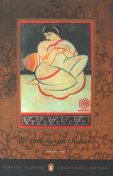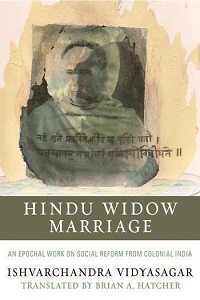

|
Hindu Widow Marriage by Ishvarchandra Vidyasagar: A Book Review Protima Pandey
1856 is hardly a year people remember because the seeds of the freedom revolution were yet to be sown. But in the social, legal and literary circles, this year was a landmark year because the Hindu Widow Remarriage Act, 1856 was passed. It is not often that one discusses the issue of whether norms dictate the law or vice versa, but in the context of the Hindu Widow Remarriage Act, it is critical to examine the social norm that existed prior to and at the time that this law was passed. Ishwarchandra Vidysagar’s two volumes on Hindu Widow Marriage laid religious, cultural and legal backdrop in 1855 which preceded the passing of the Act. Whether norms followed the law or vice versa is a debate in which the work on Vidyasagar becomes pivotal. But not just for this reason should you read Brian Hatcher’s translation of the writing of Vidysagar. This work is key to any person studying or wanting to understand not just social reform in India but also legal developments that shaped India into a democracy. And if you are looking for a casual read, this book is about social change, religious influence, legal authority and patriarchy, all woven nicely through the protagonist, the Hindu widow. Britishers, wanting to bring western, modern ideas, understanding and works of life, had repeatedly promised that they would not disrupt the social fabric of the country or tamper with the delicate balance of personal laws that were woven into the daily lives in 19th century India. The burden of social reform was therefore left on Indian scholars and thinkers alike. None was as vocal or radical as the voice and works of Ishwarchandra Vidyasagar. Although he is credited as having been an extreme, overly liberal and revolutionary voice, he did not think of his work as anti-establishment. In fact it was clear in his two volumes of work ‘Hindu Widow Marriage’ that what he was trying to do was to dig deep within existing laws, religious texts and practices to make a case for permitting marriage of Hindu women widowed and left destitute. The most striking example of Vidyasagar’s persuasiveness is his choice of words for the title of his book. He does not describe his work with any adjectives or verbs, nor makes the title a call to action. He simply makes a clear and uncomplicated statement about the content of his book. Hatcher points out that this particular work was first published as an essay in a leading Kolkata magazine and titled much like a debate ‘A proposal on the question of whether or not to promote widow marriage’. However, the same month that the essay was printed, Vidyasagar also printed the work as a standalone book, titled more concisely. One can infer that this was the wisdom and intelligence of a social reformer who knew that when addressing the masses with a commentary on a social issue, laying out the facts will hold more credibility than presenting it as his opinion or view point. At the time of writing this book, Vidyasagar was already well known as a scholar and a reformer. His word carried weight and his writing of the texts on Hindu Widow Marriage was a natural extension of his scholarly work. What is striking and I would have never fully understood this but for Hatcher’s work, is that book 2 in the series was never considered when he set out to publish his essay as a book. Even more striking is the research done by Hatcher revealing that Vidyasagar had only put out two thousand copies of Book 1 for sale, clearly anticipating his audience to be a small fraction of the Kolkata elite scholars and vastly undermining the popularity of the subject, albeit not supportive of it. In this day and age it is hard to imagine that revolutionary ideas start small--with every development in news dissected, commented and analyzed by multiple pundits, and multiple mediums of media, our world of discourse and debate is both vocal and voluminous. Not so in those times. Vidyasagar wrote in first person, extensively quoted authoritative texts from Hinduism and connected facts to the texts to make a persuasive argument. Hatcher’s brilliant introduction to the book sets the social context of Vidyasagar’s writing, making the reader understand why a topic so controversial as the marriage of Hindu widows could not have been a mere essay, which may have met skepticism, but rather had to be a well argued case, leading to a closer examination of the topic being discussed. The hardest parts to read as a woman, a public interest lawyer, a mother and a wife was all the references to volumes of work (not just by Hindu scholars, but as Hatcher researched and footnoted, by scholars who were Vidyasagar’s contemporaries) that relegated women to the status of second class citizens, much like chattels to be traded, owned and branded as belonging to either her father or her husband. But the reality is that shaping policies or promoting reform is only effective if done in the context of the prevailing social norms and mores. Keeping that in mind, the work of Vidyasagar in painstakingly quoting ancient scriptures, examining not just the language but also the various interpretations and connecting the texts to his argument was brilliant strategy. It’s only when reading Book 2 does one understand that Vidyasagar knew his topic would be met with opposition and therefore he presented his case using careful analysis and references. Hatcher’s work is important because it appears that Hatcher spent time reading not just the Sanskrit text but also Vidyasagar’s own translation of his work in English. It is precisely this effort that led Hatcher to conclude certain parts in Vidyasagar’s own English version were “lost in translation” literally. Reading Hatcher’s work will help one understand not only the literal translations of the work of Vidyasagar but also the underlying cultural, social and legal contexts that were prevailing in the time that the book was written. Without the introduction to Hatcher’s book, one would be completely lost reading the translation which is a textual translation, word by word. While I don’t read or understand Sanskrit, Hatcher’s work is a pure translation and not an interpretation, according to Hatcher. Could a native speaker have been able to translate this book better? I cannot answer that but I do know that the book was an interesting read and did not read in anyway incomplete or inaccurate. The work did not come across as a translation, where certain phrases don’t seem to convey the same meaning or feel out of place. In fact the experience is made authentic because Hatcher takes the trouble of leaving in place certain words like vivaha, punarbhu, vyabichara, etc. to, quoting Hatcher, help the reader capture the dialogue quality of the argument. In Book 2 Hatcher painstakingly translates certain arguments being made by Vidyasagar as to the meaning of the words punah punah. Here again Hatcher retains the Sanskrit words, while translating the sentence. Were he to fail to do that, the sentences would not make sense to a reader. Not only are the words repeated, their meanings, as interpreted by Vidyasagar to mean again and again and not “in birth after birth” would not come across to a reader of this book if all Hatcher did was to literally translate. The understanding of how sophisticated translators have to be is not lost on me even though I don’t read or write Sanskrit. I have had to stop in the middle of a trial because the interpreter had to first translate a text message in Spanish literally and then explain to the court why the literal translation had to be ignored and an interpretation required because of the nature of the abbreviated use of words while texting. I know it is strange to write about texting in a review of a book written a century ago, when phones were barely being invented, but the story highlights why works such as Hatcher’s are important to pick up because there are literal translators and then there are scholars, such as Hatcher. The treatises on Hindu Widow Marriage made the basis of the social reformist legislation titled Hindu Widow Remarriage Act, 1856 and it is without doubt that Vidyasagar had a big role to play in the passage of that law. A lawyer himself, Vidyasagar propounded the duty of the society towards the destitute via his work on widow remarriage, reminding Hindus that the command to take care of widows is one that has been issued in ancient texts. While the society then was not ready to take on this issue wholeheartedly, while there was no support for what Vidyasagar was proposing and while the Hindu Widows, who were the protagonists of the book, were no where involved in this debate, the book made a powerful impression on the readers at that time. Not only that, the policy makers at that time also paid attention and passed legislation paralleling the ideas that were set forth in the book. I had the good fortune to interview Hatcher during the process of writing this review and asked him about why this was a significant book for him to consider working on. Hatcher is a scholar on the works of Vidyasagar and his office is lined with Vidysagar’s books, among other books on Hinduism. He felt strongly about this work because it was a reflection of the social reformer in Vidyasagar. Having translated and written on Vidyasagar, Hatcher knew the significance of these two volumes in the life of Vidyasagar. Hatcher also wanted to ensure that the work not just be a translation (a first for these two volumes) but a book accessible to scholars and readers alike. He worked on the introduction and appendix with a view towards providing a sense of completion, contextually and from a literary point of view, so that his work would be meaningful to those who read it. It was not intended by him to be just a scholarly work (which it clearly is) but also an example of social reform through literary expression-which is what Vidyasagar wanted to do when he published these two volumes. Hatcher is fascinated by the work of Vidyasagar because he came across as a keen intellectual who had the ability to think far beyond his times and yet provide discourse that was situated within the context of the societal mores existing at the time these books were published. Hatcher has spent time studying the plight of Hindu widows traditionally and presently and it is his hope that the vision Vidyasagar had in those times be realized at least in these so called modern times. Sadly, I believe that we are still not fulfilling the vision of one of our great reformers. I will leave my social commentary to another day. For now I urge all interested in reading about the cusp of social, religious and legal discourse about Hindu Widow Marriage to read Hatcher’s brilliant and well-researched translation.
|

 Hindu Widow Marriage: An Epochal Work on Social Reform from Colonial India;
by Ishvarchandra Vidyasagar; A complete translation, with an introduction and critical notes, by Brian A. Hatcher; Columbia University Press, New York; 2011; Pp 272; ISBN: 9780231526609
Hindu Widow Marriage: An Epochal Work on Social Reform from Colonial India;
by Ishvarchandra Vidyasagar; A complete translation, with an introduction and critical notes, by Brian A. Hatcher; Columbia University Press, New York; 2011; Pp 272; ISBN: 9780231526609